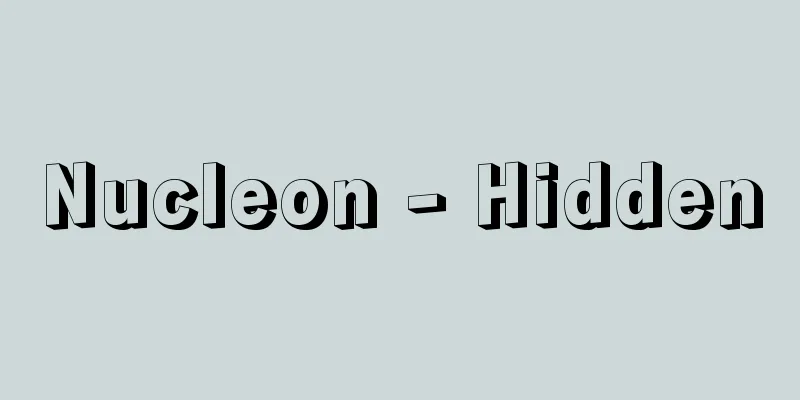Nucleon - Hidden

|
A collective term for the protons and neutrons that make up an atomic nucleus. The nucleus at the center of an atom is made up of two types of particles: protons and neutrons. Both protons and neutrons have spin 1/2 and follow Fermi-Dirac statistics, just like electrons. Therefore, in a collection of these particles, the Pauli principle applies, which states that only one particle can be in the same particle state. Protons and neutrons have almost the same mass, about 1800 times the mass of an electron. Neutrons are electrically neutral, but protons have a positive charge of the same magnitude as the charge of an electron but of the opposite sign. Protons and neutrons have almost the same properties other than their charge, and the properties of the interactions between them are also the same. Therefore, these two particles can be considered as two states of the same basic entity, the nucleon. The force between nucleons creates a strong binding energy when they are grouped together. The nuclear force between nucleons is due to the exchange of various mesons, including the π (pi) meson proposed by Hideki Yukawa, and falls under the category of strong interaction. In addition, the Coulomb interaction acts between protons. Since neutrons are about twice as heavy as electrons compared to protons, energetically, a neutron can release an electron and change into a proton. In fact, a bare neutron changes into a proton through β (beta) decay, the average lifetime of which is about 17 minutes. The decay of bare protons into other particles has not been observed. [Kiyomi Ikeda] [References] | law| | | | | | | | | | |Source: Shogakukan Encyclopedia Nipponica About Encyclopedia Nipponica Information | Legend |
|
原子核を構成している陽子と中性子をまとめた呼称。原子の中心にある原子核は2種類の粒子、陽子と中性子が集まってできたものである。陽子も中性子もともにスピン1/2で、電子と同様フェルミ‐ディラック統計に従う。したがってこれらの粒子の集合体では、同じ粒子状態には1個の粒子しか入れないというパウリの原理が働く。陽子と中性子の質量はほとんど同じで、電子の質量の約1800倍である。中性子は電気的に中性であるが、陽子は電子の電荷と同じ大きさで符号が反対の正電荷をもつ。陽子と中性子は、電荷以外の性質はほとんど同じで、またそれらの間に働いている相互作用の性質も同じである。そのためこの二つの粒子は、同じ基本実体である核子の二つの状態であるとみなせる。 核子間に働く力は、それらが集合体になったとき強い結合エネルギーを生み出す。核子間に働く核力は、湯川秀樹(ひでき)が提唱したπ(パイ)中間子をはじめとするさまざまの中間子の交換によるもので、強い相互作用の範疇(はんちゅう)に入る。また、陽子間にはクーロン相互作用が働く。中性子は陽子に比べて、電子の質量の約2倍だけ重いので、エネルギー的に、中性子は電子を放出して陽子に変わりうる。実際、裸の中性子はβ(ベータ)崩壊で陽子に変わる。その平均寿命は約17分である。裸の陽子の他の粒子への崩壊は観測されていない。 [池田清美] [参照項目] | | | | | | | | | | | |出典 小学館 日本大百科全書(ニッポニカ)日本大百科全書(ニッポニカ)について 情報 | 凡例 |
Recommend
Veto - veto
The power of one organ of a national or local gov...
Ganassi, S.
…On the other hand, as a solo instrument, it bega...
Village invitation - Murake
〘Noun〙① (Abbreviation of "muraukeshinden (mur...
Supranuclear cranial nerve palsy - supranuclear cranial nerve palsy
…When the lower motor neurons belonging to these ...
Barrymore family - Barrymore family
An American family of actors. Born to British acto...
Kankurinite - Kankurinite
…the term is a general term for minerals such as ...
Callipus cycle
A cycle of 27,759 days. This cycle was invented by...
Yamaoka Matsuake
Year of death: October 15, 1780 (November 11, 1780...
Montale - Eugenio Montale
Italian poet. Born into a wealthy merchant family...
Cold sensation - Reikansho
〘noun〙 A condition in which a woman's sexual d...
Hayton; Hethum
[Raw] 1201 [Died] 1271 King of Lesser Armenia (Cil...
yaylak
...After the end of the 16th century, some of the...
Allobathynella carinata (English spelling) Allobathynella carinata
…Since the first species, Bathynella natus , was ...
Kamitsukeno-shi - Biting Maggot
A powerful clan in the ancient Kamitsukeno Provinc...
mauve
…He was interested in chemical experiments from a...









